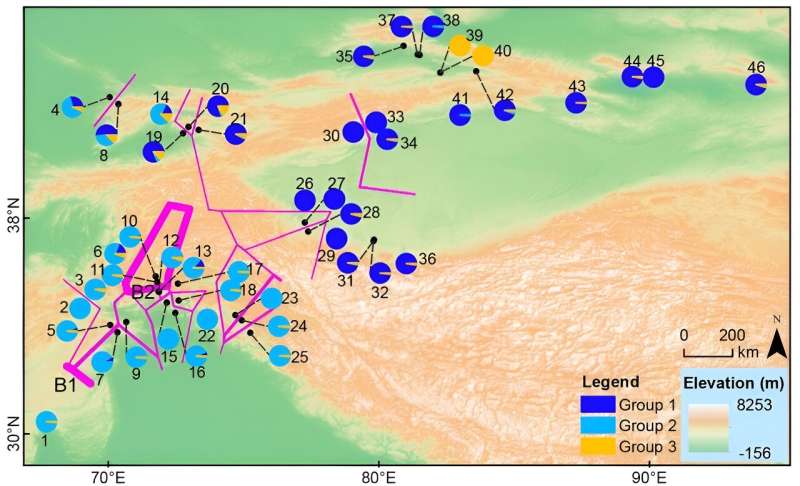This article has been reviewed according to Science X's editorial process and policies. Editors have highlighted the following attributes while ensuring the content's credibility:
fact-checked
proofread
Population genetic insights into the conservation of common walnut (Juglans regia) in Central Asia
![Bayesian inference clustering STRUCTURE analysis of 1082 individuals from 46 populations of Juglans regia. (a) The optimal K value using the delta K (ΔK) method, maximum number of populations (K), was inferred at K = 3. (b) Mean log-likelihood [Ln(K) ± SD] of the data against the number of K. (c) A Bayesian clustering of 1082 individuals of J. regia from K = 2 to K = 4. Different colors indicate different genetic groups: blue for Group 1 (G1), light blue for Group 2 (G2), and yellow for Group 3 (G3). Credit: Jie Liu, et al. Population genetic insights into the conservation of common walnut (Juglans regia) in Central Asia](https://scx1.b-cdn.net/csz/news/800a/2024/population-genetic-ins.jpg)
Understanding species distribution, differentiation and the factors affecting genetic diversity is important for sustainable conservation and effective management, as well as the rational utilization of species germplasm.
Genetic diversity, a key component of biodiversity, provides essential information on adaptation and the evolutionary capacity of plant species. Notably, the genetic diversity of forest trees is severely affected by increased harvesting (nuts, barks, timbers, etc.) and human interference (overexploitation, overgrazing, etc.), resulting in habitat fragmentation and considerable reduction of forestland area.
Juglans regia L. (Juglandaceae), popularly known as the common walnut, is a deciduous tree species typically distributed and cultivated in mountainous areas across subtropical and temperate regions, from the Balkans eastward to Asia, including China, Iran, Kazakhstan, Afghanistan and Pakistan. Presently, J. regia is cultivated in more than 60 countries, with China being the leading producer (with 31% of the total harvested). Walnut is also one of the top three most-consumed nuts in the world.
Despite walnut being one of the top three most-consumed nuts in the world, no comprehensive evaluation of walnut tree population genetics has been undertaken. This is particularly true for walnuts in Afghanistan and the Xinjiang Autonomous Region of China.
In a study published in the journal Plant Diversity, an international team of researchers has investigated the genetic diversity and population structure of 1,082 individuals from 46 populations across Central Asia through their walnut research network.

"We found moderate genetic diversity of J. regia across Central Asia, with 46 populations clustered into three groups with a weak relationship between genetic and geographic distance," states Jie Liu, senior and corresponding author of the study. "Our findings reveal that the western Himalaya might be the core region of common walnut genetic diversity in Central Asia and that, except for two populations in Gongliu Wild Walnut Valley, humans might have introduced walnut populations to Xinjiang, China."
The observed distribution of the genetic landscape has probably been affected by historical climate fluctuation, breeding systems and prolonged anthropogenic activity.
"We propose the conservation of the core genetic diversity resources in the western Himalaya and pay special attention to populations from Gongliu in Xinjiang," adds Liu. "Our findings enhance the understanding of the genetic variation throughout the distribution range of J. regia in Central Asia, which will provide a key prerequisite for evidence-based conservation and management."
More information: Linjiang Ye et al, Population genetic insights into the conservation of common walnut (Juglans regia) in Central Asia, Plant Diversity (2024). DOI: 10.1016/j.pld.2024.06.001
Provided by KeAi Communications Co., Ltd.




















